The food for poor scheme is meant for sufficient healthy and hygenic food for poor. Will this service is doing better job? Are the organisers justifying their job for poor? #KhabarLive delves these in this article.
These canteens are not exclusively for the economically poor. The basic intent of these canteens is to see that no human should live in hunger or lead a food insecure existence.
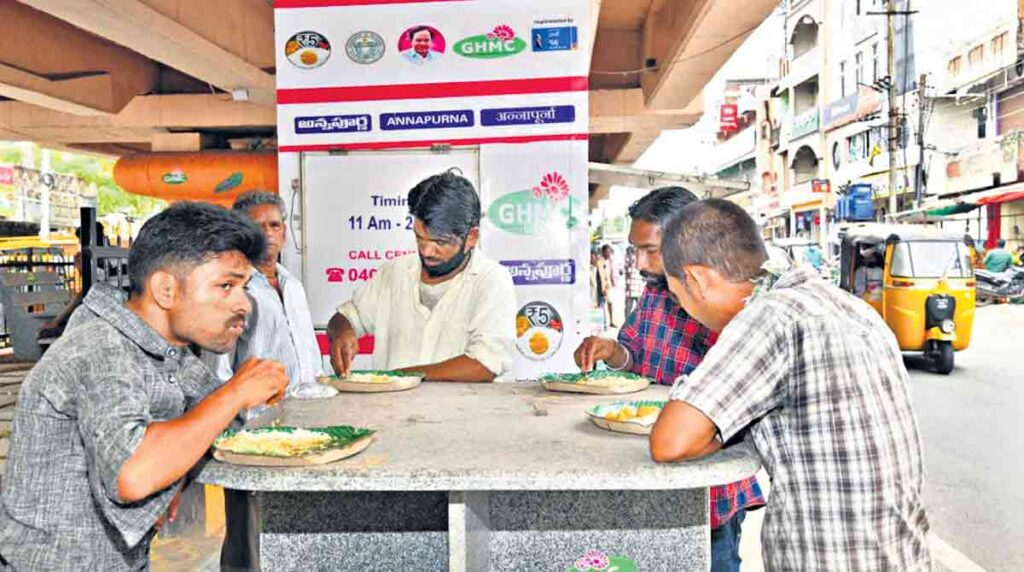
The emerging concerns of urban food insecurity are acknowledged, but very little is known on the nuanced dimensions of these. Higher urban economic growth need not by itself, imply improved access to food for all. In particular, the recent pandemic and continuing phenomenon of rising food prices along with the decline in employment in urban India, has further aggravated the food insecurity. For the urban poor, access to food is heavily dependent on monetary transactions, accentuated by the high proportion of unorganised and informal sector employment that fetches low and irregular income.
In this backdrop, the study has been carried out to understand the role of the state supported urban canteens towards improved food security in Hyderabad. While food production and the market are critical dimensions generally well discussed in various forums, there is little knowledge on how food reaches the plate. What are the constraints in availing and accessing a minimum meal per day? What role do the state and other institutions play in addressing food insecurity?
Annapurna canteens and urban food security
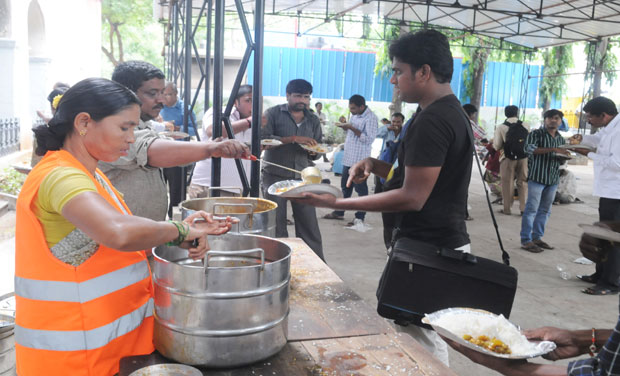
Telangana State Government introduced Annapurna canteens in Greater Hyderabad Municipal Corporation (GHMC) in the year 2014. GHMC, in collaboration with the Hare Krishna Charities provides hygienic and safe food at Rs 5 per meal. Popularly known as the ‘Five rupees meal programme,’ it was officially termed as ‘Annapurna’ by the state government. The scheme had started at eight centres in 2014 and has now expanded to 150 centres serving approximately 25,000 meals a day. In this scheme, Rs 5 is paid by the beneficiary and GHMC subsidises the remaining amount to the Hare Krishna Movement Charitable Foundation. The Hare Krishna Charity Kitchens serve around 6,750 kgs of rice, 5,265 litres of lentils and 4,500 kgs of curry, every single day.
These canteens are not exclusively for the economically poor. The basic intent of these canteens is to see that no human should live in hunger or lead a food insecure existence. These canteens are located in Hyderabad covering a vast, diverse population belonging to different economic, occupation, ethnic, religious, and gender identities. Our intent was to understand how inclusive these canteens are in provisioning of food to various segments of the society and how exclusion manifests in different forms.
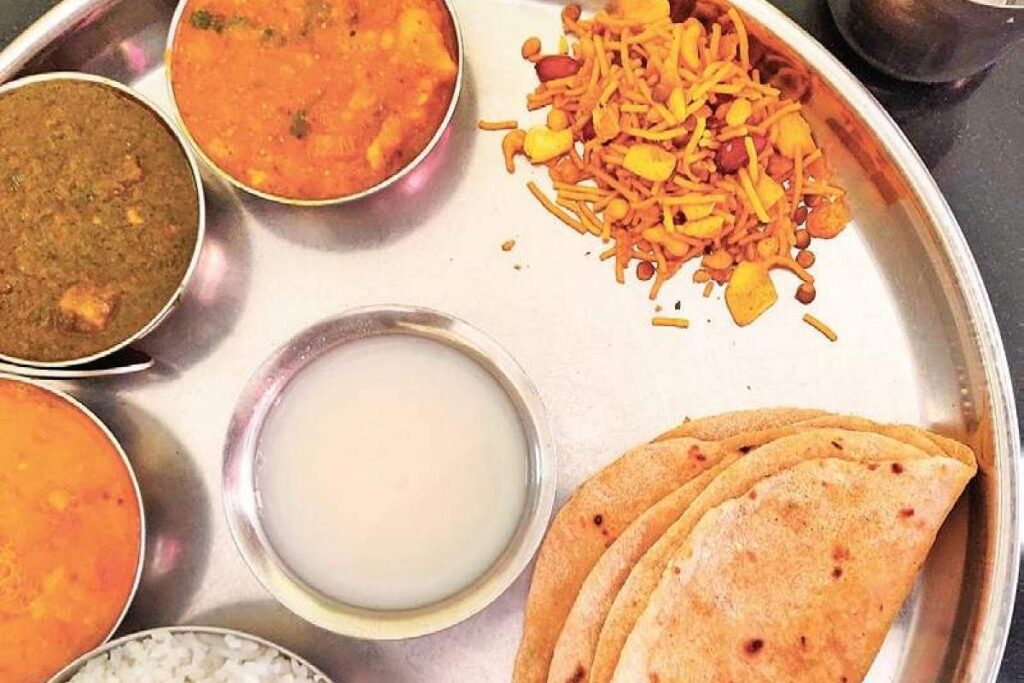
GHMC Telangana canteens provide only lunch for approximately four hours. We went to the canteens located across diverse demographic orientations including the canteens near the bus stops, hospitals, IT corridor, and railway station. The food provided by each canteen varies every day. However, rice and sambar are consistent in the menu.
Each canteen attracts a different composition of customers including the homeless on the one extreme and junior doctors on the other. The supply volume differs across canteens depending upon the demand for the food. The canteen’s ambience varies across locations and the surrounding environment. Customers desire to have a shelter and place to be seated while consuming food at every canteen.
However, these facilities are available only in Hitech City, and Kukatpally Zonal Commissioner’s office. Canteens at Goods shed, Moosapet; Yellammabanda, Kukatpally and Yousufguda are poorly maintained despite attracting numerous customers. Several customers we interacted with, had complaints on the supply of water packets, lack of variety of vegetables in the menu, long queue, and unhygienic surroundings.
Location of the canteens matters in accessing them
Observations at the sales points revealed that the locations with high concentration of working urban population and bus stops had more sales. Canteens located at KPHB Metro Station and HiTech City Metro Station catered to a large number of consumers (approximately 700) during the lunch hours. The composition of the customers generally include low-income groups.
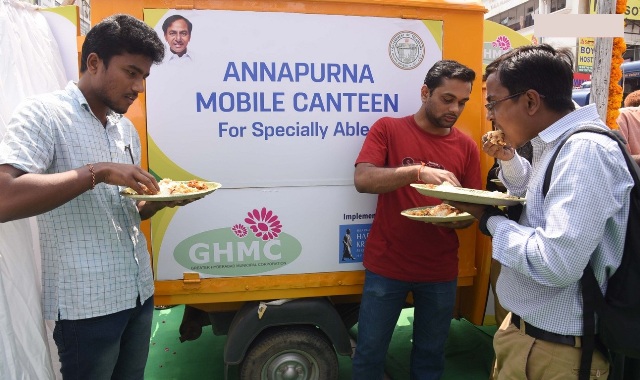
“If I have to eat in a hotel in this area, it would cost me around Rs 100 per plate and here it is just Rs 5. I can save more money eating here rather than eating in any hotel,” said one of the respondents availing the facility of the canteen at HiTech City, Madhapur canteen.
The number of rice cans supplied is also an indicator of food demand in each canteen. For example, canteens at HiTech City are supplied with 11 cans (approximately 25 kgs per can) of rice. These other canteens with a high supply of cans are on KPHB and Miyapur X Road and in Osmania General Hospital. In contrast, Moosapet Goods Shed and Nampally Station canteens sell about two rice cans each. The canteen at Hitech City attracts consumers ranging from homeless to the junior doctors who are working in the vicinity. Good ambience and aesthetic of the canteen is one of the important attractions across social and economic groups.
“This canteen is well maintained. Only this canteen has seating arrangements*among all canteens in Hyderabad. I have eaten in many canteens. But I like to have food in this canteen, because of the good ambience and it is hygienic,” said one of the customers at HiTech City canteen.
Some canteens open at 10:30 am and close at 3:30 pm while some others open at 11:30 am and close by 1:30 pm. The functioning of the canteens also depends upon the demand and the perception of the respective canteen supervisor. “I open this canteen at 10:30 am by seeing the public in front of the canteen for food. They work as maids, municipality women who sweep the roads, and slum population who live nearby,” said the canteen’s supervisor at Yellammabanda.
Closer the canteens to each other, more the customers
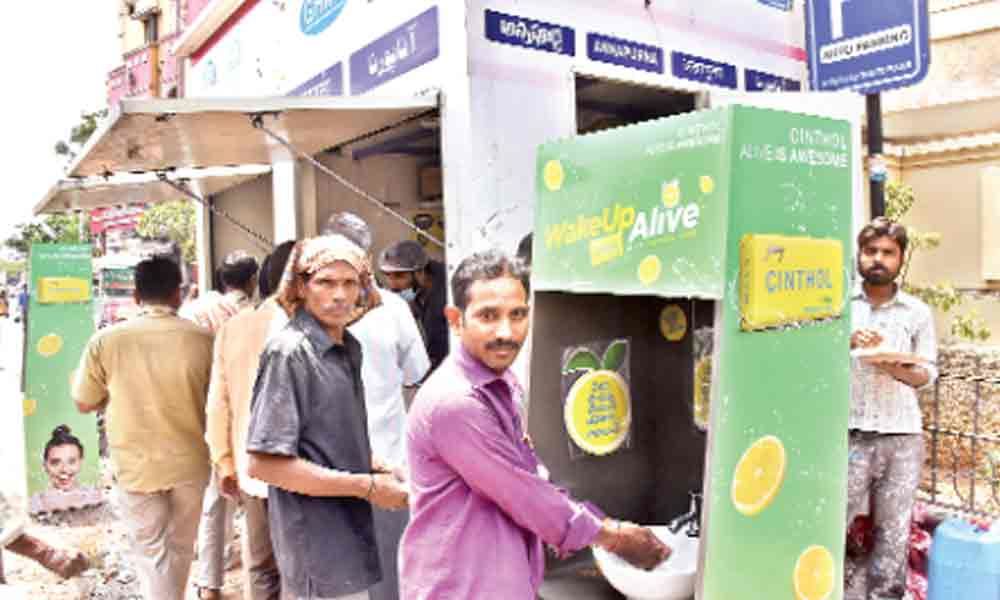
The canteens’ locality and the running time are major factors for some of the customers to utilise the canteen for their food needs. Some localities have more than one canteen nearby while some do not have any. Lingampally has three canteens in close proximity and functions at the similar time. Nampally Gandhi Bhavan, Koti, MGBS, Patancheru, Beeramguda have proximity features. Others like Uppal, HiTech City and Osmania General Hospital do not have these features. Availability of canteens in close proximity helps the customers to avail the low-priced food provided by the Annapurna canteen. “I have gone to Beeramguda canteen, it was closed, so I came here to have food as this canteen runs for longer time than that canteen,” said a customer at Patancheru Bus Stand canteen.
The respective canteen’s supervisors have varied opinions on the functioning of the canteen based upon the composition of the customers and location. At HiTech City, Miyapur X Roads, and Yousufguda canteens, the supervisors opine that the canteen benefits the homeless more and it is providing good food at cheaper price.
The remuneration is based upon the sale of rice cans each day and is fixed at Rs 1.10 paise per customer. On an average, they earn Rs 7,000 per month. Most of the supervisors across the canteens in Hyderabad are male. The Patancheru and KP Zonal Commissioner’s Office, Moosapet are the only exceptions having female supervisors.
In some canteens, management has hired employees to serve food on a part-time basis. They serve the food in the stipulated functioning time and get back to another work. “I have been working here since the inception of the canteen. I see many people coming here and having food. Beggars come, students come, auto drivers come, labour come, and drunkards also come. Some people ask for more food, and more water packets. But I cannot give, since it is fixed for one person. They eat and wash their hands here only. Some people put the plates in the dustbin and some throw and make this place dirty,” said a canteen supervisor near the Patancheru Bus Stand.
Food quality better in Hyderabad area
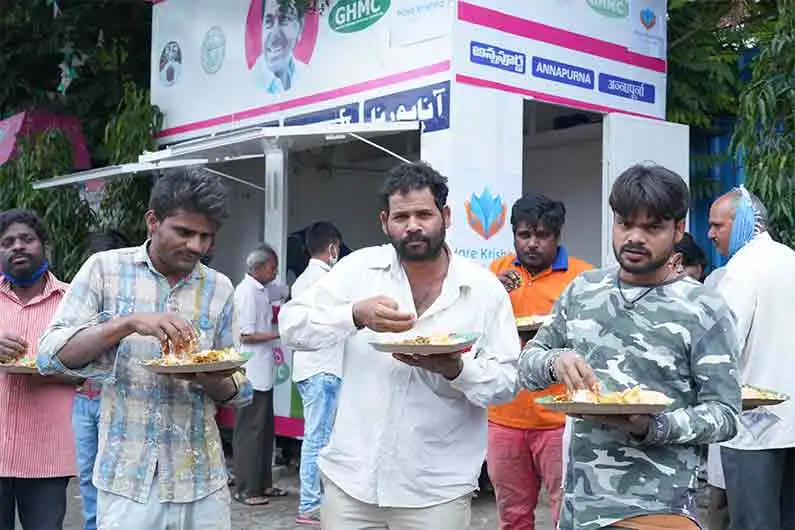
Composition of the customers of the canteens vary across the locations of the city. In the Secunderabad area, the majority of the customers include construction workers and daily wage earners, vegetable sellers, auto drivers, and a good number of homeless. In the Hyderabad area, the composition of the customers extended to the food and other delivery boys, taxi drivers, entry level IT and hospital employees, and GHMC workers. Our interactions revealed that the perception of food quality varies across the locations. One of the determining factors could be the composition of the customers. Food quality was found to be low in Secunderabad areas compared with Hyderabad areas.
“I know that we do not get food anywhere at this rate but see this curry, the potato is unpeeled, rice is not cooked properly and it is hard, they have added flour in sambar for its thickness. I appreciate the government’s idea to give food to us at cheaper rates but if they can also look into the quality, we will be very happy,” said a mason at Chilakalaguda canteen in Secunderabad. “Rice is not cooked and curry is bad. If I want to eat at a hotel I can, but I have to save money, so I come to this canteen to have food at a cheaper rate. Government has to look into this issue and provide us with a good quality of food,” said a person who works as a security guard at the same canteen.
But the views have been found to be different by a different set of customers. Taxi, auto, and truck drivers found the canteen’s food quality to be adequately good. These people travel through the city and avail services of various canteens whereas the first set of customers work near a particular canteen and eat food from the same canteen on a regular basis.
The composition of the canteen’s supervisor varies across the canteens and depending on the situation can make them vulnerable to various threats. “I have been working here since the lockdown. I have been verbally abused by the customers if I do not give extra water packets, food quality is found to be bad. I complained to the concerned people, but received no help, instead they said, it will be like that only and I have to manage the situation. It is becoming very difficult for me to serve food,” said the female supervisor at one of the canteens.
During lockdown the government kept the canteens open and provided free meals through the chain of 250 canteens in the respective geographical limits. The main purpose of this was to serve the needy during the lockdown. Patient attendees, daily wage workers, hawkers, people living in shelter homes, and others have availed the service of these canteens during the lockdown.
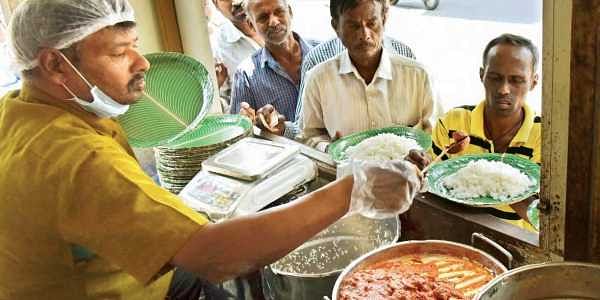
Hygiene and ambience of the surrounding is one of the neglected areas across most of the canteens. Interestingly, recently GHMC had initiated to serve the food in a thin paper plate kept over a plastic plate. Each canteen was given approximately 60 plastic plates.
Customers were expected to consume the food in the green thin plate, put the plastic plate as a base and should return the plastic plate after their consumption. But supervisors across canteens had complained that many customers were not returning the plastic plates. It is difficult for them to chase the customers for not returning the plastic plates.
Need to make the canteens more customer friendly

Making the canteens accessible, hygienic, and providing basic infrastructure and proper seating arrangements can attract various segments of the population who are hungry and looking for affordable good quality food. It is equally important to make these canteens accessible to various strata of the society including women and children. For this, the place needs to be felt safe for the canteen supervisors and customers alike. Having women in the role of canteen service provision can help in making the canteens more accessible for the women customers as observed in Amma’s canteens in Tamil Nadu.
Branding the canteens for the poor may be counterproductive. Along with food, affordable safe drinking water is another challenge the city dwellers face. Integrating adequate drinking water provision in these canteen premises would be further useful.
To link it further, women self-help groups (SHGs) can play an important role in such basic food provisioning services. This requires the state’s willingness and proactiveness in engaging them in this service. It will not only be useful towards addressing food security, but also livelihood security of the women engaged in the services.
Nonetheless, it is important to recognize urban food insecurity is a glaring issue that needs urgent and large-scale intervention by the state in provisioning affordable nutritious food. These should go beyond a few cities as examples and reach to the urban-scape of the entire nation. #KhabarLive #hyderabadlive #hydnews
